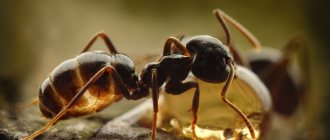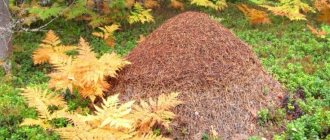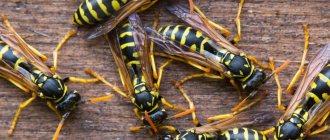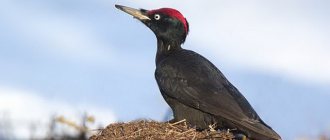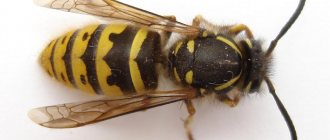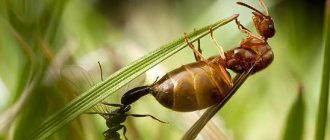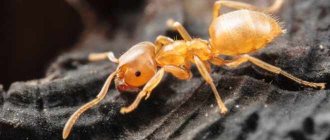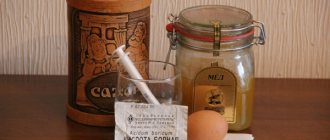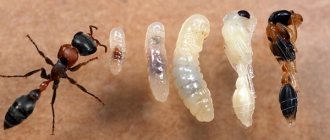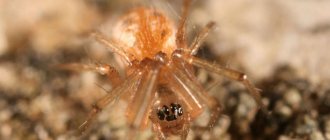These insects live in large families that persist for several years; in fact, all the ants in such a colony are relatives from a biological point of view, and from a social point of view, this is a city whose population is strictly divided into castes and strictly organized. In fact, we can say that a parallel civilization is seething and developing under our feet.
We interact through speech, gestures and facial expressions, and ants communicate through the exchange of food and through smells, each ant has its own unique smell, and each family has its own unique shades of smells, thanks to which the insects feel that a stranger has entered their home. Their interaction is also carried out using pheromones, using which insects inform each other about the location of food or danger.
We have known since school how an anthill works and how complicated everything is in it, but myrmecologists are engaged in more serious research into the ant community.
What do ants look like?
The body of an ant (in Latin - Formicidae) consists of three sections: head, chest and abdomen. All parts of the body are connected to each other by elastic bridges, which makes them very flexible, mobile and resourceful. There are three pairs of limbs on the chest. The head is usually large and equipped with powerful mandibles, necessary for grinding food, holding it, or generally for defense.
The life cycle of an ant includes the following stages: egg, larva, pupa and adult. At the larval stage, the diet of the larva determines who will be born: a queen, infertile females, males, or simply working individuals. This entire process takes from 1 to 2 months.
How long do ants live?
The lifespan of ants depends on many criteria. Their longevity is influenced by the species - forest and reaper ants live from 3 to 5 years, while the working individual of the pharaoh ant can last only two months.
An important role in life expectancy is played by which caste a particular individual belongs to. If it is a uterus, then it can live from 5 to 25 years. Males who perform their function as a fertilization machine take literally 1-2 weeks. The life of workers and soldiers is short-lived - up to a maximum of 3 months.
_____________________________________________________________________________
Ant "table of ranks"
Communication and mutual contact between fellow tribesmen is carried out using channels (signal and food). The colony is conventionally divided into “detachments”:
- Workers.
- Soldiers.
- Females.
- Males.
At the head of this legion is the queen, also known as the queen . The uterus has the largest size. This is a real egg production conveyor. The working group of ants is required to care for eggs and pupae, search for and prepare food, repair and strengthen the anthill. A detachment of guard ants, the so-called soldiers, perform protective functions, guard entrances and deal with strangers. Females and males are destined for the role of participants in the process of reproduction.
Ants in nature and in formicarium
We have all seen an anthill at least once in our lives, be it a forest, desert or steppe. The structure of an anthill is almost the same in any landscape. Its upper part is intended for living in the warm season, and the lower (underground) for wintering.
An anthill can be compared to a multi-storey building or a miniature million-plus city, which has everything. Bedrooms, dining rooms, maternity ward, kindergarten, special farms where they grow aphids to feed on their milk (honeydew) and many other rooms. They are necessary for living in a complex social system of 1 million individuals.
A formicarium is an ant farm, that is, an artificially created anthill. It is created for various scientific purposes to monitor the life of ants. In this case, everything depends on the person, and not on Mother Nature.
In order for the colony to live and reproduce, it is necessary to create labyrinths for walking and darkened chambers. You will have to feed the population of the formicarium (carbohydrates and proteins) and water, protect it from stress, ultraviolet rays, and maintain humidity.
The life expectancy of the inhabitants of the formicarium completely depends on the person, his scientific knowledge and experience.
_____________________________________________________________________________
What do ants and bees have in common?
The closest relatives of ants are bees and wasps. All of them belong to the order Hymenoptera. There is one single important difference: ants are 100% social insects, unlike bees, which are solitary. The lifespan of a bee is many times shorter than that of an ant.
The commonality between an anthill and a hive lies in their social hierarchy - both have a Queen or a Queen. Males - in bees they are called drones, and many working individuals - provide the vital functions of all other inhabitants.
_____________________________________________________________________________
An anthill is not the best neighborhood
Of course, forest ants bring invaluable benefits - destruction of carrion, maintaining the population of birds and small animals. It is categorically forbidden to destroy the housing of forest orderlies, but to tolerate being next to each other in your own house or apartment is unacceptable. That is why, at the first sign of the appearance of these insects in or near the house, you need to take measures - getting rid of trash, using traditional methods of control. If the moment is missed and the colony has reached an impressive size, the best solution would be to contact specialists.
How does the life of ants work?
For example, we will take: the red house (pharaonic) ant, the red forest ant and the black garden ant. All these species primarily differ in size, color, habitat and life expectancy.
Characteristic features inherent only in each individual type of them.
- The forest ant usually lives in one family. The female, having flown out after the mating flight, having become fertilized, does not seek to build a new home, but returns to her family.
- A garden ant whose queen has flown out for fertilization does not return back to the anthill, but creates a new colony, independently, without the help of workers.
- The red house (pharaonic) ant, not only is it adapted to the human environment, but also the process of reproduction (swarming) occurs all year round. They disperse “by “budding” the nest: a group of worker ants with larvae and pupae, as well as several “queens,” moves to another place suitable for reproduction.”
_____________________________________________________________________________
Kinds
The classification of ants is complicated by the similarity of some species to each other, the appearance of hybrids and twin varieties. With the course of evolution, some genera die out and the survivors resettle, which are forced to adapt to climate change and their usual habitat. The most numerous types of ants :
1. Red ants . The name was given because of the reddish color of the abdomen of females, while males have a black body with a brownish tint to the legs. Ordinary individuals of this species are small - up to 5 mm, the uterus can reach 7 mm.
Red ants are widespread in European countries, the Far East, Siberia and the Urals; they prefer coniferous and mixed forests, in which they play the role of protectors, exterminating pests.
Typically, representatives of the type settle under large stones or fallen trees, but are capable of building an anthill up to 2 meters high with a complex system of passages and numerous exits.
2. Small forest ants . A species of red-brown insects with a black abdomen is listed in the Red Book of many European countries, where it is endangered. Small forest ants are widespread mainly in coniferous forests of Russia, Sweden, Germany, etc. Despite the name of the genus, its representatives reach 14 mm in size and are able to build a dwelling from fallen pine needles about 2.5 meters high.
3. Garden ants . Perhaps the most numerous species, spread throughout Russia, Portugal and Great Britain. The color of the body, covered with microscopic hairs, can be either black or dark brown, but the size varies depending on the social role: queens reach 10 mm, males - 6, working individuals are the smallest - up to 5 mm.
Favorite places to build a house are old stumps and fallen trees. This species feeds on the waste products of aphids, so where these pests exist, you can find many small anthills up to 30 cm high. The peculiarity of black garden ants is the lifespan of the queen: she is capable of reproducing for almost three decades.
4. Pharaoh ants . The variety, named after its place of origin - in Egypt, has spread throughout the world. Individuals are among the smallest in the class and vary in color depending on their role in the community: brownish-yellow females reach 4.5 mm, black males - up to 3.5 mm, and ordinary workers - 2 mm.
It is noteworthy that the males of this species have wings, but in females they grow only during the mating period, after which they are bitten off by worker ants. Pharaoh ants live in human homes and are able to build an anthill almost anywhere - from the foundation of a house to household appliances.
5. Carpenter ants . Settled in forest-steppe zones of Russia and Western Europe. To build a home, they prefer the bark of trees, in which they make many passages, thereby causing damage to forest plantations; they can settle in rotten stumps or wooden buildings. The variety is represented by red ants with a brownish tint to the body, reaching 10 mm in length.
6. Giant ants . The habitat of insects with a bright black body, reaching 33 mm in size, is the humid forests of South America. The variety, in addition to its impressive dimensions, is interesting due to the absence of queens, whose role is taken on by female worker ants during the mating period. Males are larger than females and have permanent wings. Giant insects are underground inhabitants; their anthills are located at a depth of 40 cm and are intended for a small family of 30-40 individuals.
Other common varieties are:
— Ants are bulldogs, named because of their large jaw relative to the body, which allows them to capture prey.
— Ants are nomads who do not have a permanent habitat and create temporary homes and their own bodies.
— Pale-footed ants, so named because of their contrasting color: their body is black and their legs are light brown, the eyes of these insects are unusually large.
— Crazy ants, characterized by chaotic behavior, but capable of creating communities uniting several colonies with a high level of organization and several queens that do not quarrel with each other.
— Honey ants are common in places with arid climates; they store dew and plant juices in their abdomens, which feed all members of the community. Mexicans squeeze honey from these insects, which is considered a delicacy.
- Bullet ants. They are able to deal even with small vertebrates, which they eat as food, cutting them with sharp jaws. They protect themselves by releasing a paralyzing neurotoxin, which causes anaphylactic shock in humans, often resulting in death.
— Soldier ants. The peculiarity of the species is the clear organization of nomadic life activity, division into battalion groups. Due to the fact that the queen reaches 5 centimeters in size when laying eggs, the variety is recognized as the largest known.
- Fire ants. They are dangerous to all living things and are capable of destroying most of the living beings in the territory of their settlement. Despite their size of 4-6 mm, they are extremely aggressive and attack, releasing poison into the victim’s body.
There is an opinion that ants with wings constitute a separate species, but scientists believe otherwise: representatives of many genera, both female and male, have temporary or permanent wings. They serve for convenient movement to the habitat of other families and the formation of new colonies.
Interesting facts from the life of ants
Did you know that:
- the amount of intelligence (learning) in ants reduces their lifespan and fertility
- a worker ant has a brain (mushroom bodies) almost twice as large as a soldier's
- Of the total number, only 3% of ants constantly work in anthills; 25% of individuals have never been seen at work. And 72% of insects either work or don’t work, about half the time
- Scout ants are the intellectual elite of the anthill; they transmit encoded texts of the movement route to each working individual and make up about 1% of the entire population of the anthill
- “Circles of death” in legionnaire ants occur due to a failure of orientation on the terrain; they begin to move one after another at the level of pheromones and twist into a spiral. The weakest die in the center of this circle
- The collection of milk (honeydew) from aphids is carried out by a special caste - shepherds. With their paws they tickle aphids, getting them to secrete droplets of honeydew and pass them on to workers for transportation.
- some species (leaf cutters) have divisions of workers (subcastes): some (small in size) work only inside the anthill, never leaving it. And others (large sizes) are only outside, ensuring the cutting and delivery of leaves.
_____________________________________________________________________________
Ant food
Ants require abundant nutrition, are predators and destroy plant pests. Adults consume carbon food: plant juice, their seeds and nectar, mushrooms, vegetables, fruits, and sweets.
The larvae are provided with protein nutrition, which includes insects and invertebrate animals: mealyworms, cicadas, aphids, scale insects and others. To do this, worker ants pick up already dead individuals and attack the living ones.
People's homes sometimes become ideal places for the dangerous breeding of pharaoh ants. There is a lot of warmth and food, in search of which insects are tireless and inventive, overcoming any obstacles.
Finding a power source, they form a whole highway to it, along which they move in large quantities. Ants often cause damage to people's homes, gardens and vegetable gardens.
The life of ants in nature: what is it like?
Scientists have proven that ants have intelligence. All life in an anthill is subject to a strict individual and group hierarchy. Anthills come in different heights and depths, and different diameters. It all depends on the natural conditions in which the insects live and what their numbers are.
A complex eusocial (eu-good) community of ants starts from 1 million individuals. For example, the depth of ant chambers in Brazil reaches 3 meters, while the number of such families reaches tens of millions of individuals.
The very emergence of a new anthill and its further existence directly depends on the females. Therefore, it can be firmly stated that the longevity of the anthill depends only on the females – the Queens.
Like bees, ants are preparing for the coming winter. The process is very labor-intensive because you need to thoroughly prepare yourself (food supplies) and prepare your home (anthill) for winter so that it is warm and humid.
When cold weather sets in, life in the anthill slows down, but does not stop. The ants become inactive, the queen practically stops producing new offspring, and the larvae also slow down the process of further development. The eggs that the female lays during this period are included in her diet.
Red house ants, also known as pharaoh ants, having adapted to life in the human environment, do not slow down (accelerate) the pace of their development even in winter. In well-heated apartment buildings, where above-zero temperatures (+23+28) and comfortable room humidity are constantly maintained, they reproduce all year round.
_____________________________________________________________________________
Insect housing
An amazing architectural structure with many chambers, passages, floors, exits and entrances. The height of the anthill reaches several meters, the diameter is about 5 m, with the size of one ant up to 8 mm. Millions of individuals live in one house. The entire colony numbers several million insects.
Outside there is a mound of earth with twigs, sticks, leaves, needles, and other building materials that an ant can handle. The cone-shaped shape of the anthill warms up well in the sun, ensures free air circulation, and protects from raindrops.
Inside, everything is much more complicated. The structure of the anthill resembles a multi-story building with a huge number of apartments. Divided into 2 parts. The upper one is intended for life in the warm season, the lower one goes deep into the ground, providing a safe, prosperous wintering. Each of them has chambers resembling separate rooms:
- Queen's apartments;
- egg chamber;
- room for larvae;
- food pantry;
- warehouse for waste and garbage;
- tomb;
- room with aphids;
- bedrooms for wintering.
The chambers are connected to each other by numerous passages. The entrances are guarded and tightly closed for the winter.
Insect housing Ant families are constantly replenished, and housing expansion is required. Construction continues every year. In case of danger - if the anthill is damaged or destroyed, residents immediately begin constructing a new building, dragging food supplies, larvae, and eggs there.
Interesting!
The largest anthill in size was discovered in the Tomsk region. The height is 3 m, the diameter is 5 m. It took approximately 25 years to build. Nearby, members of this family are building new housing, identical in appearance.
The importance of ants in nature and human life
The importance of ants in nature directly depends on the number of anthills. The larger the population of an anthill, the more benefits it will provide.
Through their vital activity, ants accelerate the humus of plant residues, improve aeration and water exchange in the soil. In the process, the soil is enriched with chemical elements that are very necessary for plants.
Anthills are used as places of settlement for other animals. They create particularly favorable conditions for the development of a number of microorganisms.
Ants play an important role as orderlies. They collect all decomposed organic remains in an anthill and eat it.
Anthills serve not only as a source of food necessary for the normal development of chicks, but also as “bird sanitary inspection stations”, in which birds, “bathing”, are cleansed of parasites.
Ants also provide humanity with products that are impossible to do without in medicine (formic alcohol). Hemostatic drugs are prepared from them.
In nature, nothing is created just like that, everything is natural and ants are no exception.
To lose ants means to destroy many natural connections and slow down the development of certain species of insects and birds. This will inevitably lead to an increase in pests in nature, and most importantly, a decrease in forests - the “lungs” of the Earth.
Damage caused by ants to humans
Negative factors for humans include the fact that ants, due to their vital activity, cause inconvenience to a person of an aesthetic nature. People don’t like the ever-scurrying hordes of ants in the kitchen and other rooms, but it’s their own fault (unsanitary conditions).
Also, negative factors can be attributed at the theoretical level - these are ants as carriers of various diseases (pathogenic bacteria, microbes). Theoretically, microorganisms can remain on their paws, through which food becomes infected.
Timur Shapovalov
Please rate the material
comments powered by HyperComments
Lifestyle
Due to their huge numbers, ants influence the surrounding flora and fauna. They loosen the soil, saturating it with oxygen, and create conditions in anthills that are favorable for the development of microorganisms that saturate the soil with essential nutrients. The waste products of ants act as fertilizer for the soil. It’s not for nothing that greenery grows wildly near anthills. In the forest, ants actively promote the growth of spruce and deciduous trees.
Anthill
Ants are hard workers, capable of carrying loads weighing 20 times their body weight, and also covering long distances. In addition, ants are social insects. In ant families there is a certain hierarchy, the violation of which threatens the death of the entire colony.
